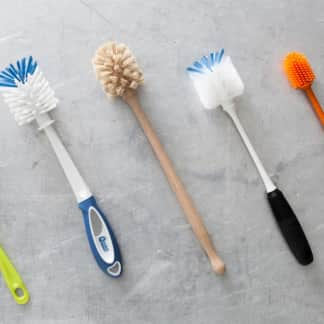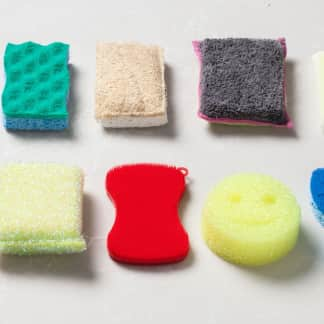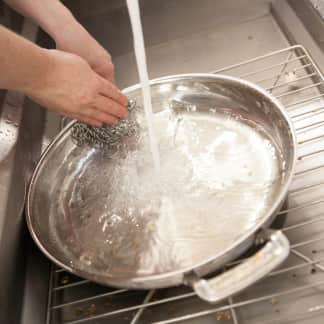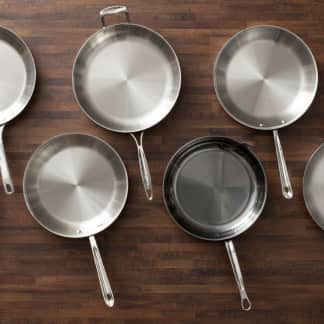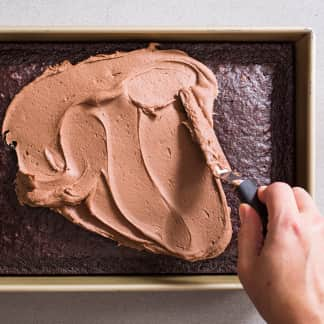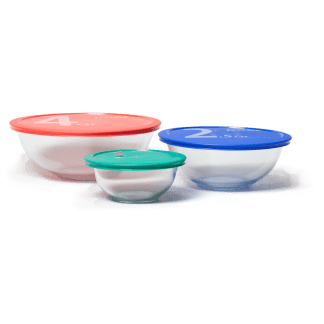The best scrub brushes have stiff, durable bristles that easily scrub away messes and comfortable handles that are pleasant to grip, even when applying intense pressure. The Full Circle Tenacious C Cast Iron Brush + Scraper won our top spot by powering through difficult cooked-on food residues without showing too much wear. Its ultrastiff, well-spaced, flared bristles effectively scoured cookware and didn’t trap food debris, and we liked the feel of its rounded wooden handle.

When tackling the most stubborn messes—whether it’s cooked-on egg, crusty bits of frizzled cheese, or baked-on tomato sauce—we often bypass a sponge entirely and reach for a scrub brush. Scrub brushes offer a few advantages over sponges: Their bristles are better at cutting through tough messes, and food is less likely to cling to them; their handles help provide good leverage for scrubbing; and they keep our hands away from dirty dishes and cookware.

We scrambled eggs in stainless-steel skillets, intentionally creating a stubborn, stuck-on mess to test the brushes’ scrubbing power.
What’s the Best Material for a Scrub Brush?
Most brushes on the market have plastic handles, though some handles are made of wood or stainless steel. The majority of scrub brushes are made with plastic—usually nylon—bristles, which range in texture from soft and malleable to stiff and unyielding depending on manufacturing factors such as bristle length, thickness, and density. Nylon bristles are non-porous, so they won’t absorb water or residue from food messes and will thus hold up better to heavy-duty use over time.

If you’re avoiding plastic, there are also brushes with bristles made of natural fibers. One popular choice is tampico fiber, which is derived from the agave plant. Natural fibers are generally softer and more porous than nylon, which means they are more likely to stain, get bent out of shape, and absorb water (and odor) over time. We preferred synthetic bristles, since they were more durable and easier to clean and maintain.
What to Look for
- Stiff Bristles: A good scrub brush is only as reliable as its bristles. Brushes with stiffer bristles more effectively cut through tough, burnt-on food remnants, leaving behind sparkling cookware. Stiff bristles were also more durable than soft bristles, and they held their shape over time instead of fraying or becoming permanently bent or compacted against the brush heads.
- Widely Flared Bristles: We preferred bristles that flared out from the brushes’ heads. Widely flared bristles increased the scrubbing surface area, which allowed us to scrub off more food with fewer passes. Bristles that flared out from the heads’ sides were more effective at reaching into corners.

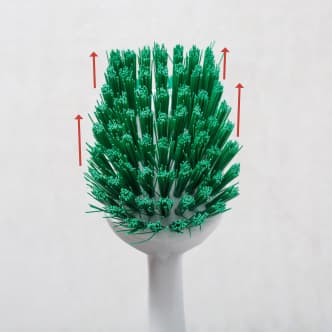
Bristles that flared outward from the brush heads’ sides fit into narrow corners and covered more surface area than non-flared bristles.
- Well-Spaced Bristle Clusters: Brushes sporting clusters of bristles with relatively wide spaces between the clusters trapped fewer food particles and were much easier to rinse clean.
- Gently Angled Handles: Top-performing brushes had handles that were gently sloped or curved away from their heads, which helped us maintain good leverage for scrubbing yet created enough clearance to keep our fingers free of the mess.

- Textured, Rounded Handles: The best handles were coated in soft, grippy plastic or made of slightly rough wood; both allowed for easy control even when our hands were covered in slick suds and water. We also found that rounded handles were the most comfortable to hold.

Nice to Have
- Wide, Sharp Scrapers: Many models had heads with scrapers: flat tabs of plastic with sharp edges meant to help us scrape up especially stubborn bits of food. When working with softer-bristled brushes, we found those with wide, sharp scrapers far more helpful than those with narrow, dull scrapers. However, overall we preferred brushes with bristles that were sufficiently stiff and worked well enough to clean dishes without the help of a scraper.

What to Avoid
- Soft Bristles: Brushes with softer, more flexible bristles were unable to scrape up cooked-on messes as efficiently as their stiff-bristled counterparts; they just smeared food around. When used to scrub cast-iron pans crusted with rendered burger fat and metal baking pans sticky with burnt-on tomato paste, mustard, and molasses, softer bristles bent out of shape. This made for unkempt, frayed brush heads whose already poor performance worsened over time.
- Straight Bristles: Heads with straight, unflared bristles too often knocked into skillet edges or baking pan corners without reaching into them, keeping us from tackling every bit of mess.

- Tightly Clustered Bristles: Brushes with no gaps between their bristle clusters trapped more food, and it took additional rinses under the faucet, cycles in the dishwasher, or even whacks on the sink edge to get them to relinquish debris.
- Steeply Angled or Curved Handles: Some brushes’ handles bent away sharply from their heads at angles that measured more than 45 degrees, which raised our elbows and positioned our hands away from the action. Curved handles forced us into similarly uncomfortable positions and made for awkward scrubbing.
- Smooth Handles: Handles that were too smooth caused our hands to slide around in the soapy water and occasionally slip off the brush, especially during vigorous scrubbing.
Other Considerations
- Handle Length: Testers’ preferences for handle lengths generally came down to the sizes of their hands. Those with smaller hands mostly preferred shorter handles, noting that these gave them more control and felt less awkward and uncomfortable to hold than longer handles. Testers with larger hands often recommended brushes with longer handles, which distanced their hands from the mess and felt less cramped. Our winner has a relatively short handle, but its unparalleled scrubbing ability and ultradurable bristles make it the top choice for all but the largest-handed users, who may be more comfortable wielding our (slightly less effective) runner-up.
The Tests
- Scrub cooked-on scrambled eggs off stainless-steel skillet
- Scrub a baked-on mixture of yellow mustard, tomato paste, and molasses off metal baking pan
- Scrub cast-iron skillet covered in seared burger remnants
- Clean metal mixing bowl covered in biscuit dough
- Wash brushes 10 times according to manufacturer’s instructions
- Have additional testers use brushes at home and provide feedback
How We Rated
- Performance: We evaluated how effectively the brushes scrubbed away a variety of messes.
- Ease of Use: We assessed whether the brushes were comfortable to hold and operate and whether any design features made them harder to use.
- Cleanup: We tested how easy it was to clean the brushes, noting whether debris got trapped in their bristles and was difficult to dislodge.
- Durability: We noted whether the brushes sustained any damage, odors, or stains across weeks of testing.


















